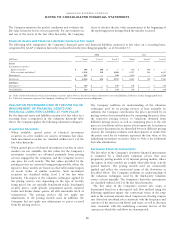American Express 2012 Annual Report Download - page 78
Download and view the complete annual report
Please find page 78 of the 2012 American Express annual report below. You can navigate through the pages in the report by either clicking on the pages listed below, or by using the keyword search tool below to find specific information within the annual report.
AMERICAN EXPRESS COMPANY
NOTES TO CONSOLIDATED FINANCIAL STATEMENTS
The following table provides information with respect to the
Company’s interest income recognized and average balances of
impaired cardmember loans and receivables, which are not
significant for ICS and GCS, for the years ended December 31:
2012
(Millions)
Interest
Income
Recognized
Average
Balance
Cardmember Loans:
U.S. Card Services $ 60 $ 1,221
International Card Services 16 75
Cardmember Receivables:
U.S. Card Services — 135
Total $ 76 $ 1,431
2011
(Millions)
Interest
Income
Recognized
Average
Balance
Cardmember Loans:
U.S. Card Services $ 67 $ 1,498
International Card Services 26 98
Cardmember Receivables:
U.S. Card Services — 145
Total $ 93 $ 1,741
CARDMEMBER LOANS AND RECEIVABLES MODIFIED
AS TDRS
The following table provides additional information with respect
to the cardmember loans and receivables modified as TDRs,
which are not significant for ICS, for the years ended
December 31:
2012
(Accounts in thousands,
Dollars in millions)
Number of
Accounts
Aggregated
Pre-
Modification
Outstanding
Balances(a)
Aggregated
Post-
Modification
Outstanding
Balances(a)
Troubled Debt
Restructurings:
U.S. Card Services —
Cardmember Loans 106 $ 779 $ 762
U.S. Card Services —
Cardmember Receivables 37 425 418
Total(b) 143 $ 1,204 $ 1,180
2011
(Accounts in thousands,
Dollars in millions)
Number of
Accounts
Aggregated
Pre-
Modification
Outstanding
Balances(a)
Aggregated
Post-
Modification
Outstanding
Balances(a)
Troubled Debt
Restructurings:
U.S. Card Services —
Cardmember Loans 147 $ 1,110 $ 1,064
U.S. Card Services —
Cardmember Receivables 50 402 388
Total(b) 197 $ 1,512 $ 1,452
(a) Includes principal and accrued interest.
(b) The difference between the pre- and post-modification outstanding balances
is attributable to amounts charged off for cardmember loans and receivables
being resolved through the Company’s short-term settlement programs.
As described previously, the Company’s cardmember loans and
receivables modification programs may include (i) reducing the
interest rate, (ii) reducing the outstanding balance,
(iii) suspending delinquency fees and (iv) placing the
cardmember on a fixed payment plan not exceeding 60 months.
Upon entering the modification program, the cardmember’s
ability to make future purchases is either cancelled, or in certain
cases suspended until successfully exiting the modification
program.
The Company has evaluated the primary financial effects of the
impact of the changes to an account upon modification as
follows:
폷Interest Rate Reduction: For the years ended December 31,
2012 and 2011, the average interest rate reduction was 12
percentage points and 11 percentage points, respectively. None
of these interest rate reductions had a significant impact on
interest on loans in the Consolidated Statements of Income.
The Company does not offer interest rate reduction programs
for U.S. Card Services (USCS) cardmember receivables as these
receivables are non-interest bearing.
폷Outstanding Balance Reduction: The table above presents the
financial effects to the Company as a result of reducing the
outstanding balance for short-term settlement programs. The
difference between the pre- and post-modification outstanding
balances represents the amount that either has been written off
or will be written off upon successful completion of the
settlement program.
폷Payment Term Extension: For the years ended December 31,
2012 and 2011, the average payment term extension was
approximately 13 months and 15 months, respectively, for
USCS cardmember receivables. For USCS cardmember loans,
there have been no payment term extensions.
76
























